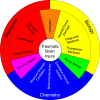Cavitation in soft matter
- PMID: 32291337
- PMCID: PMC7196784
- DOI: 10.1073/pnas.1920168117
Cavitation in soft matter
Abstract
Cavitation is the sudden, unstable expansion of a void or bubble within a liquid or solid subjected to a negative hydrostatic stress. Cavitation rheology is a field emerging from the development of a suite of materials characterization, damage quantification, and therapeutic techniques that exploit the physical principles of cavitation. Cavitation rheology is inherently complex and broad in scope with wide-ranging applications in the biology, chemistry, materials, and mechanics communities. This perspective aims to drive collaboration among these communities and guide discussion by defining a common core of high-priority goals while highlighting emerging opportunities in the field of cavitation rheology. A brief overview of the mechanics and dynamics of cavitation in soft matter is presented. This overview is followed by a discussion of the overarching goals of cavitation rheology and an overview of common experimental techniques. The larger unmet needs and challenges of cavitation in soft matter are then presented alongside specific opportunities for researchers from different disciplines to contribute to the field.
Keywords: TBI; bubble; rheology; soft solids; traumatic brain injury.
Conflict of interest statement
The authors declare no competing interest.
Figures




References
-
- Rambod E., Beizaie M., Shusser M., Milo S., Gharib M., A physical model describing the mechanism for formation of gas microbubbles in patients with mitral mechanical heart valves. Ann. Biomed. Eng. 27, 774–792 (1999). - PubMed
-
- Kurosawa Y., et al. , Basic study of brain injury mechanism caused by cavitation. Conf. Proc. IEEE Eng. Med. Biol. Soc. 2009, 7224–7227 (2009). - PubMed
-
- Hong Y., Sarntinoranont M., Subhash G., Canchi S., King M. A., Localized tissue surrogate deformation due to controlled single bubble cavitation. Exp. Mech. 56, 97–109 (2016).
-
- Salzar R., Treichler D., Wardlaw A., Weiss G., Goeller J., Experimental investigation of cavitation as a possible damage mechanism in blast-induced traumatic brain injury in post-mortem human subject heads. J. Neurotrauma 34, 1589–1602 (2017). - PubMed
Publication types
LinkOut - more resources
Full Text Sources

